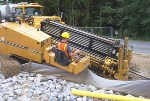
HDD: An Environmental Preservation Tool
What comes to mind when I say "green construction." Windmills? No. The answer is horizontal directional drilling (HDD) — a method used to install pipe, fiber optic and power lines and other utilities under such sensitive areas as a river or wetlands. This process minimizes environmental impact.
First developed in the late 1970s, HDD can be used to accurately place a line over a few hundred feet or more than one mile in length. It isn't less expensive than conventional trenching, but the environmental benefits along with the advantages of avoiding the highway and street closures or otherwise disrupting neighborhoods or businesses make the economics work.
As the number of projects using HDD has grown, so has the environmental restrictions and limitations placed on HDD contractors. To protect a natural habitat or wetlands doesn't mean no one can step foot into the area. A couple of land surveyors, whose work is essential to the accuracy of the drill, aren't allowed to walk the site, although grazing cattle or local hunters with four wheelers are fine. Keep in mind what is being gained: The goal is to leave the area as it was found, not to punish the contractor. It is ironic because early contractors and environmentalist were partners along with project owners, working closely to ensure proper project design.
The entire environmental movement seems to be schizophrenic. In efforts to avoid a single oil or gas well, the landscape is plastered with "green" windmills. Do environmentalists take into account the energy and resources required to manufacture and construct each of these monstrosities? I doubt that the impacted wildlife (who must endure high-pitch harmonics or avoid treacherous airspace) consider it green. If all this activity is "acceptable" because of the end goal, then why are HDD contractors restricted from simply following proper procedures?
Too many of today's environmentalists grade themselves on their ability to disrupt rather than work with business people who are trying to do a good job. They need to learn how HDD works from HDD contractors (not consultants) and how to use it to its full potential. For example, nothing is more important than the guidance and documentation of the directional drill's pilot hole. High-pressure gas lines have radius limitations and a straight drill is essential. Underground right-of-ways are becoming congested and the number of HDD incidents is on the rise. A pinpoint guidance method exists to help avoid such incidents. The drill bit's location through the entire drill can be confirmed and verified through DC tracking, which uses an artificial magnetic field at the surface. Even though there is nothing more accurate, many HDD consultants and, therefore, environmentalist, do not understand the process.
The blame doesn't lay with the environmentalists; they are more likely the solution. Sadly, the current structure of the HDD industry — project owner, HDD consultant and environmentalist, then HDD contractor — will require tremendous individual effort from everyone involved.
─ John English is founder and president of Horizontal Technology Inc., headquartered in Houston, Texas.
Posted by John English on Jan 24, 2011